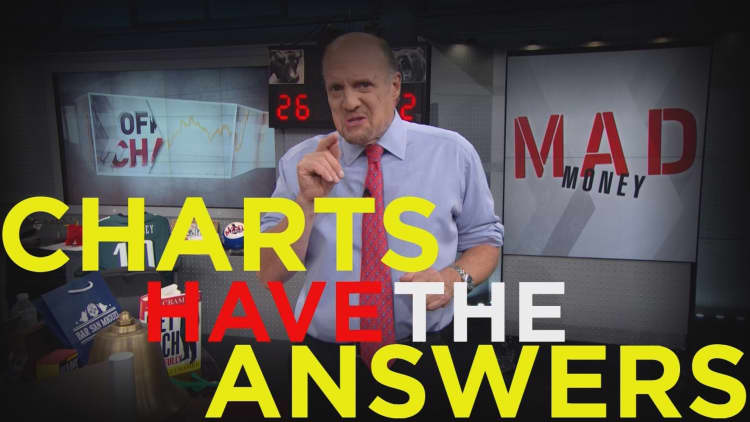
Jim Cramer isn't a chartist, but he understands why the charts are so important to predict the next big stock moves.
"Why do charts work? First, you must consider them as if they are footprints at a scene of a crime. These footprints trace out what big money managers might be doing with their buying and selling of stocks," the "Mad Money" host said.
The second reason to care about charts, Cramer said, is that there is a remarkable self-fulfilling nature of charting stocks. Some of the best investment ideas can come from chart inspired brainstorming sessions. However, Cramer has found that the best way to produce results is with a careful melding of both fundamentals and technicals.
A good technical analysis means being able to find the indicators that will help to determine the overall direction of the market, especially since so many stocks are influenced by the stock futures.
So, while homework on the fundamentals of a company is still important, it's a bad idea to pull the trigger on a stock without looking at the chart first.
Sometimes, finding a bottom after a long decline can be incredibly lucrative. In 2009, when the market was in a severe decline, Cramer had the sense that the decline's velocity was lessening. He then began looking for the most bulletproof stock he could find.
He came up with AT&T, which had a lot going for it with a roll out of the Apple iPhone that was expected to produce record profits for the company.
Cramer first checked with four chartists, who all agreed that AT&T had a strong foundation. They also agreed that it had established a nadir in 2008 at $21 with the tsunami of selling. They figured this out by looking at the volume and saw that it had expanded to a level far in excess of a normal period's trading. That was a sign that the sellers were exhausted.
"As long as sellers overwhelm buyers with their dumping, no base can form. A climax is a sign that those potential sellers who had been holding on for some time are finally giving up en masse," Cramer said.
Investors can determine if a stock is overbought or oversold by charting the ratio of higher closes, also known as the relative strength index, or RSI. This is a momentum oscillator that measures the direction that a stock is going, and the velocity of the move.
Cramer also matches the RSI of an individual stock to something else, maybe the relative strength of its sector or a larger index, and then measures the price action historically. He looks for anomalies where strength stands out, because that is a sign that there is a pending move or a change in momentum.
The inverse can also be true; a stock can also fall so fast that investors should expect it to snap back because it is technically oversold. These patterns are reliable indicators that a change in direction is about to occur, and are terrific action points.
So, for investors that are debating whether to buy a stock, have done all the research and find that the stock is overbought, Cramer said to wait for the inevitable pullback that almost always happens.
The most simple and reliable chart pattern out there is one that Cramer dreads.
Unfortunately, Cramer learned not to ignore the head-and-shoulders pattern the hard way when his charitable trust bought Alcoa in the low teens in 2010, and ultimately took a loss because it was a really early buy. Yet, what worried him was that even after an initial positive reaction, the stock dropped. So, a few days later, Cramer assumed it would take out its $18 level and went back to buy more.
Cramer was wrong — extremely wrong.
"Yes, just like a human's head. That is the most frightening pattern in the chart book," Cramer said.
Another chart type that Cramer relies on is called the cup-and-handle pattern. In fact, he has used the reliance of this pattern to stay in stocks that he might have otherwise sold.
A cup and handle pattern is one that resembles a cup with a handle. The cup creates a 'U' shape with a downward drifting handle.
Cramer learned the lesson of the beautiful cup-and-handle opportunity in the stock of Domino's. He was thinking about selling the stock, when chartist Ed Ponsi set him straight and told him not to.
Ponsi pointed out that Domino's had reached a pivotal moment and was getting ready to launch into a bigger move. Sure enough, Ponsi nailed it—and Domino's proceeded to double and then some. It turned out that while Cramer was nervous about the stock, it was actually consolidating and getting ready to power higher.
"Technicians and fundamentalists can co-exist. Make peace with them both, and I bet you will make a heck of a lot more money than if you are blind to one or the other and certainly to both," Cramer said.



